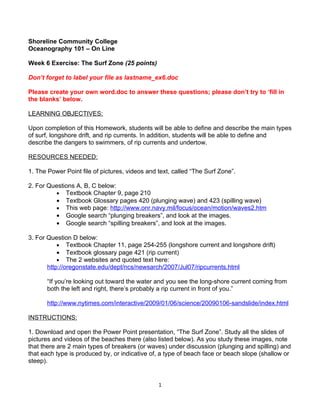
Week 6 exercise surf zone
- 1. Shoreline Community College Oceanography 101 – On Line Week 6 Exercise: The Surf Zone (25 points) Don’t forget to label your file as lastname_ex6.doc Please create your own word.doc to answer these questions; please don’t try to ‘fill in the blanks’ below. LEARNING OBJECTIVES: Upon completion of this Homework, students will be able to define and describe the main types of surf, longshore drift, and rip currents. In addition, students will be able to define and describe the dangers to swimmers, of rip currents and undertow. RESOURCES NEEDED: 1. The Power Point file of pictures, videos and text, called “The Surf Zone”. 2. For Questions A, B, C below: • Textbook Chapter 9, page 210 • Textbook Glossary pages 420 (plunging wave) and 423 (spilling wave) • This web page: http://www.onr.navy.mil/focus/ocean/motion/waves2.htm • Google search “plunging breakers”, and look at the images. • Google search “spilling breakers”, and look at the images. 3. For Question D below: • Textbook Chapter 11, page 254-255 (longshore current and longshore drift) • Textbook glossary page 421 (rip current) • The 2 websites and quoted text here: http://oregonstate.edu/dept/ncs/newsarch/2007/Jul07/ripcurrents.html “If you’re looking out toward the water and you see the long-shore current coming from both the left and right, there’s probably a rip current in front of you.” http://www.nytimes.com/interactive/2009/01/06/science/20090106-sandslide/index.html INSTRUCTIONS: 1. Download and open the Power Point presentation, “The Surf Zone”. Study all the slides of pictures and videos of the beaches there (also listed below). As you study these images, note that there are 2 main types of breakers (or waves) under discussion (plunging and spilling) and that each type is produced by, or indicative of, a type of beach face or beach slope (shallow or steep). 1
- 2. Ireland New Zealand Baja, Mexico: Pozo Hondo, Los Cerritos, Playa Grande, San Jose del Cabo, Cabo Pulmo Yucatan, Mexico: Puerto Morelos (with offshore reef), Cancun Cape Cod, Massachusetts 2. Answer the following questions on a separate page, with the title and your name: A. Plunging Breakers (6 points): note that the most severe type of breaker is called a surging wave. We are only working with plunging and spilling waves here. Also note that you may find it difficult at first to differentiate between plunging and spilling breakers. Watch the videos several times each, as the distinction will show up with repeat viewing. Also, as you watch the waves themselves, take careful note of the relative slopes of the beach faces. 1. Which of the beaches above illustrate, for the most part, “plunging” breakers? 2. Which of these beaches with plunging breakers clearly show(s) a steep beach face? 3. What is the significance (or relationship) of this kind of beach slope with respect to the plunging breakers? B. Spilling Breakers (6 points): 1. Which of the beaches above illustrate, for the most part, “spilling” breakers? 2. What is the general slope of these beaches, steep or shallow? 3. What is the significance (or relationship) of this kind of beach slope with respect to the spilling breakers? C. Reef Breakers (2 points): In the Puerto Morelos Reef pictures, you can see surf breaking on the offshore reef 1. What kind of breakers are these, plunging or spilling? If you can’t tell from the photos, consider that the reef has a fairly steep slope on the seaward side. D. Rip (tides or currents???) At the beach called Playa Grande, you will see a red warning sign, advising guests not to swim due to the Rip Tide there. 1. Define Rip Tide (if you can; be careful, this IS a trick question!). (2 points) 2. Define Rip Current. In particular, what kind of beach process must be present for a rip current to form? (2 points) 3. According to the beach photos themselves (NOT the sign), do you see evidence of a Rip Current at Playa Grande? Perceiving this evidence (or lack of it), is not easy to 2
- 3. do, especially in pictures or videos. Please read the description of rip current in the text (Glossary page 421) AND through Rob Holman’s website and quote in the resources above. (2 points) 4. What process is necessary for a rip current to form? (2 points) 5. If there is no Rip Current at Playa Grande, how else would you warn potential swimmers here? Look again at the seaward flow of water after the surf breaks; look at the slope of the beach face and think about the fundamental force of nature which creates that flow of water (also called the backwash or undertow). What is the fundamental force of nature that creates danger at this beach? (3 points) 3